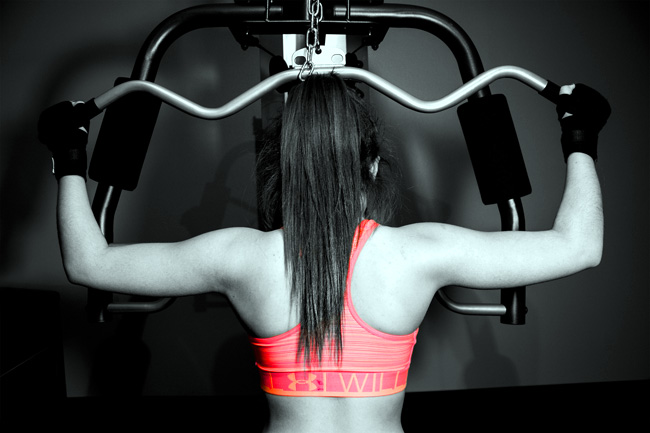The lat pulldown is a common fitness exercise used to strengthen the arms, shoulders and back muscles. This is a maximum strength one-repetition max (1RM) test, which determines the maximum amount that can be lifted once. This test uses similar muscle groups to the pull-up test, though in the pull-up test the participant's body weight must be lifted. In the lat pulldown, the lifted weight can be varied. 1RM tests can be performed with many other fitness exercises too.
test purpose: This test measures upper body muscle strength.
equipment required: lat pulldown gym equipment.
pre-test: Explain the test procedures to the subject. Perform screening of health risks and obtain informed consent. Prepare forms and record basic information such as age, height, body weight, gender and test conditions. Perform a standard warm-up including lifting progressively higher weights. See more details of pre-test procedures.
equipment preparation: Attach a long horizontal bar to the lat pulldown machine if available, and adjust the thigh pads so that when you are sitting your knees are at right angles and the feet flat on the ground.
procedure: Set an appropriate weight that can be easily lifted. Grasp the bar using a wide overhand grip (hands slightly wider than shoulder width, palms facing away from the body) and sit down maintaining the upper body in an upright position, slightly leaning back from the hips. Start with the arms fully extended. Pull the bar down in front of your face to just below the level of the chin. The pull-down should be done in a smooth motion - jerky motions and hunching or swinging the body is not permitted. Slowly release the bar back to the starting position by straightening your arms. After each successful attempt, an appropriate increase in weight (e.g. 5-10 kilos) should be added to the load. Rest for at least one minute between lift attempts. Repeat until a failure occurs (the bar down not reach to below the chin).
scoring: record the maximum lift.
 lat pulldown exercise
lat pulldown exercise target population: sports in which upper body strength is important, such as rowing.
advantages: the equipment is readily available in most gyms, and this test is easy and quick to perform.
disadvantages: due to variations in technique and whether the arms are fully extended or the chin reaches the bar, the scoring can be subjective, therefore it is difficult to standardize the results.
comments: The results of this test may be specific to the equipment used, so is best to use the same equipment for test-retest measures. The type of grip should also be recorded with the results. The warm-up procedure should also be recorded and repeated with further testing. If any variation in technique was allowed, this should be recorded on the results sheet for referral when the test is repeated. Having a familiarization and practice session is advantageous, as Sperandei et al. (2005) found a tendency to increased loads on a second day's testing.
References:
- Sperandei, Sandro & A. P. de Barros, Marcos & Oliveira, Carlos. (2005). One Repetition Maximum Test Reliability In The Lat Pulldown. Medicine and Science in Sports and Exercise - MED SCI SPORT EXERCISE. 37. 10.1097/00005768-200505001-01349.
Similar Tests
- Pull-Ups — general description of pull-up tests
- Flexed-arm hang — how long someone can remain with the chin held above a horizontal bar.
- 1RM Bench Press Test — measure of the maximal weight you can bench press with one repetition.
- 1-RM Tests — measure of the maximal weight a subject can lift with one repetition.
Related Pages
- About the Lat Pulldown exercise
- About the Lat Pulldown Machine
- Lat Pull-downs: Improving the effectiveness of pull-downs
- Lat Pull-downs Behind the Neck - An exercise to avoid
- Overhand or underhand - a description of each of the grip types
- Other strength tests


 Current Events
Current Events